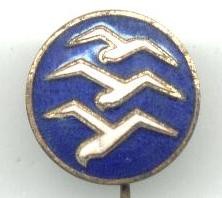Wolfgang Klemperer
1954
about
(1893-1965) SSA Co-Founder; SSA Vice President; Glider Designer/Builder; Chairman National Glider Association (precursor SSA); OSTIV Trustee; Sierra Wave Project; 1st Person to Break Orville Wright's 1911 Soaring Record
Awards
Eaton Trophy 1963; International "C" Badge #1 1921; World/National Records;
Bio
WORLD "C" BADGE NUMBER ONE!
That alone is qualification for election to the Soaring Hall of Fame. But Dr. Klemperer was so much more.

Klemp, as he was known to his many friends, was born in Dresden, Germany, in 1893. the son of a Prague banker (who disciplined him teutonically) and a mother (artistic and loving). Throughout his life, Klemp maintained the qualities of self-discipline, imagination and generosity. His interest in flight was manifested around age 14 when he began building model airplanes, gliders and homebuilt hang-gliders. At age 17 he was chosen by Count von Zepplein to study under the Count's special tutelage.
Since his father was an Austro-Hungarian citizen, Klemp served in the Austrian military winning medals as a reconnaissance pilot and instructor at the Alpine front. When ordered to bomb Venice, he flew beyond the city and released his bombs in a swamp - a difficult decision for a man accustomed to follow instructions. Following his service, he returned to Dresden to complete his studies with honors in 1920. He then went to Aachen as the assistant to Prof. Theodore von Karman.
Since there were no post-war restrictions on gliding, and under the watchful eye of the Belgian occupation forces, Klemp designed and built sailplanes. He won the first gliding contest in 1920 by soaring the windward side of the Wasserkuppe in his "Black Devil". In 1921, soaring an improved version, the "Blue Mouse," he flew the first cross-country staying aloft for 13 minutes exceeding Orville Wright's previous 9 minute 45 second flight and earning Soaring Certificate #1.
In 1924 he emigrated to America as research manager of Goodyear-Zeppelin in Akron, Ohio. He continued his soaring activities making the first U.S. Distance flight - 16 miles - in Pennsylvania. He organized soaring clubs, test-flew new aircraft and developed glider-towing by car, motorboat, airplane and blimp. He did intend to tow a glider behind a blimp to the Cleveland Air Races but the glider kept overtaking the blimp and Klemp was nearly fatally entangled in his tow cable but released and landed safely.
After much searching, he selected Elmira as the site for the national soaring contests and the first one was held there in 1930. In 1936 he moved to Southern California as head of special research for Douglas Aircraft Company where he eventually became Chief of Missiles Research. He retired in 1958 but remained with Douglas (until his death in 1965) as a Staff Assistant, Director of Product Research and European liaison.
Klemp was very active in California soaring including flying at early sites Palos Verdes, Arvin, El Mirage, Twentynine Palms, Torrey Pines and Bishop where he was Chief Engineer of the Sierra Mountain Wave Project in the 1950s. He was Chairman of the National Glider Association (precursor to SSA), SSA Co-Founder, SSA Vice President, OSTIV Trustee and received SSA's highest award, the Eaton Trophy, in 1963. The OSTIV Klemperer Award was established in his honor in 1958.
We close with a Douglas Aircraft tribute and then a comment from his daughter: "... One wonders whether we shall ever again know so familiarly, and with such full awareness of the privilege, another like Dr. Klemperer. He was part of an era in which a few giants led the way for a profession which now embraces so many disciples that superlatives tend to be applied more to teams than to individuals ..."
Eleanor Klemperer Velarde: "He would have been embarrassed by this praise, for he was an overly humble man who saw his contributions as his duty to repay the privilege of a good life. He once told me in a rare, unguarded moment that he wished he could have done more - that he had fallen far short of his goal ..."
Klemp was a true scientist and inventor to whom nothing was impossible - if it was imaginable, it could be done, there only remained the way to do it. Those of us who had the high honor of knowing Klemp will be forever grateful for that privilege.
(Adapted from "KLEMP" by Eleanor Klemperer Velarde, written for a college history course in 1970)